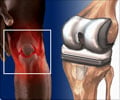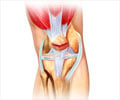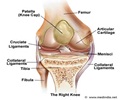A new study reveals that number of total knee replacement surgeries more than tripled and the number of total hip replacements doubled between 1993 and 2009.

Previous studies have found a strong link between a higher body mass index (BMI) and knee osteoarthritis. The effects of weight on hip osteoarthritis were less clear. In this study, researchers reviewed at least 10 years of national data (through 2009) on TKR and THR volume, length of hospital stay, in-hospital mortality, and orthopaedic workforce trends.
Among the study findings:
- TKR volume has far outpaced that of THR for patients with a body mass index (BMI) of ≥25 kg/m² (persons with a BMI of ≥25 kg/m² and <30 kg/m² are considered overweight; patients with a BMI of ≥30 kg/m², obese), but not for patients with a BMI of <25 kg/m²
- In 1993, surgeons performed 1.16 TKRs for every THR, but this ratio grew to 1.60 by 2009.
- Patients ages 18 to 64 experienced a more rapid rise in overweight and obesity, compared to patients over age 65.
- From 1997 to 2009, the share of patients ages 18 to 64 undergoing TKR rose 56 percent, compared with only 35 percent for THR.
- Surgeon per-case reimbursement for TKR fell from approximately $3,000 in 1995 to $1,560 in 2009, and surgeon fees for THR from $2,840 to $1,460. As the data represents an approximate 48 percent drop in fees for both procedures, surgeons do not appear to be performing more TKRs over THRs because of higher reimbursement.
- Hospital reimbursement, length of hospital stay and in-hospital mortality pertaining to TKR and THR also comparably declined between 1995 and 2009.
"We found that this differential growth rate in total knee replacement procedures could not be attributed to changes in physician or hospital payments, length of hospital stays, in-hospital death rates, or surgical work force characteristics," said Dr. Derman. "Because excess body weight appears to be more damaging to the knee than to the hip, the increasing prevalence of overweight and obesity may explain the growing demand for knee replacements over hip replacements.
"If rates of overweight and obesity continue to climb, we should expect further acceleration in the number of knee replacements performed annually in the U.S. with a more modest increase in hip replacement volumes," said Dr. Derman. "This knowledge can inform future policy decisions regarding health care funding and surgical workforce training as well as guide allocation of preventative health resources."
Study Details
Total knee replacement and THR volume, length of hospital stay and in-hospital mortality data was obtained from the Nationwide Inpatient Sample, part of the U.S. Department of Health and Human Services (HHS) Healthcare Cost and Utilization Project (HCUP), which in 2009 included details on more than eight million admissions at more than 1,000 hospitals in 44 states. The International Classification of Diseases, Ninth Revision, Clinical Modification (ICD-9-CM) procedure codes for primary TKR and primary THR were used to define relevant procedures. Reimbursement was calculated using available information from the Federal Register and Centers for Medicare and Medicaid Services databases, and trends in body mass index from the Centers for Disease Control and Prevention (CDC) Behavioral Risk Factor Surveillance System. Orthopaedic workforce information was obtained from the American Academy of Orthopaedic Surgeons.
Advertisements
Source-Eurekalert














